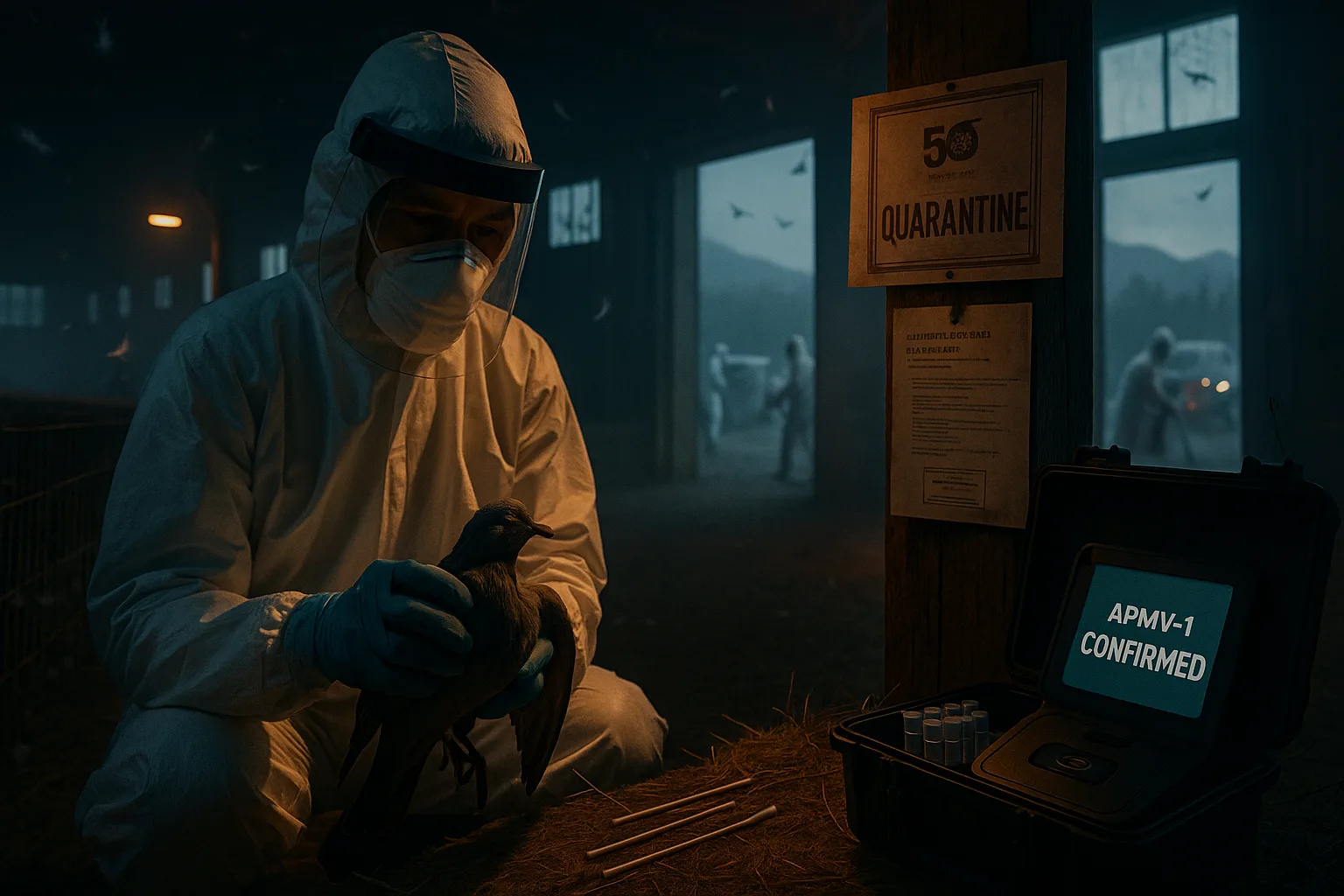Newcastle Disease Reemerges in Canadian Poultry After 52 Years of Freedom

On May 28, 2025, an unexpected and alarming development unfolded in British Columbia’s poultry industry. The Canadian Food Inspection Agency (CFIA) received urgent reports of unexplained bird deaths at two commercial squab pigeon farms in Chilliwack, a region known for its vibrant agricultural activity. Just one week later, on June 4, laboratory confirmation revealed a shocking truth: velogenic Newcastle disease (VND)—a highly virulent strain of avian paramyxovirus type 1 (APMV-1)—had re-entered Canadian poultry for the first time since 1973. This marked the end of a remarkable 52-year streak during which Canada had maintained its status as a Newcastle disease-free nation, a feat achieved in December 1973 after a major eradication effort.
Genetic analysis of the virus strain showed a close match to pigeon paramyxoviruses circulating in Eurasia, suggesting a potential international origin. While the exact route of transmission remains under investigation, scientists are exploring multiple pathways, including wild bird migration, contaminated equipment or footwear, and international trade.
Key Outbreak Facts
| Location | Flock Type | Detection Date | Last Canadian Case |
|---|---|---|---|
| Chilliwack, British Columbia | Commercial squab pigeons | May 28, 2025 | 1973 |
Understanding Newcastle Disease: A Lethal Threat to Avian Life
Newcastle disease is a highly contagious viral infection that affects more than 250 bird species, including domestic poultry, wild birds, and even pet birds. The disease is caused by virulent strains of avian paramyxovirus type 1 (APMV-1), and it attacks multiple body systems:
- Respiratory System: Symptoms include gasping, coughing, sneezing, and nasal discharge.
- Neurological System: Affected birds may display head twisting (torticollis), paralysis, tremors, or abnormal circling behavior.
- Gastrointestinal System: Greenish diarrhea and loss of appetite are common signs.
In severe cases—especially with the velogenic form—mortality rates can approach 100% in unvaccinated flocks. While chickens are often the most vulnerable, this outbreak involved pigeons, which typically carry milder forms of the virus. The emergence of a deadly velogenic strain in pigeons raises new concerns about the evolution and spread of the disease.
Although human infections are rare, the virus can cause mild conjunctivitis (pink eye) in individuals with direct contact with infected birds. The CFIA has reassured the public that properly cooked poultry products remain safe for consumption.
Canada’s Emergency Response: A Multi-Layered Containment Strategy
Upon confirmation of the outbreak, the CFIA swiftly implemented a comprehensive containment strategy to prevent further spread:
- Immediate Quarantine: All movement of birds, equipment, and personnel was restricted at the infected farms.
- Depopulation: Infected flocks were humanely culled to eliminate sources of viral shedding.
- Establishment of Disease Control Zones: A Primary Control Zone (PCZ) was set up within a 10-kilometer radius of the outbreak sites, with strict permitting for any movement across zone boundaries.
- Surveillance Expansion: Enhanced monitoring was initiated in nearby commercial flocks and wild bird populations to detect any further spread.
- Compensation Framework: Farmers affected by the depopulation orders will receive compensation under Canada’s Compensation for Destroyed Animals and Things Regulations, though the emotional and economic toll on producers is immeasurable.
CFIA Disease Control Measures Overview
| Measure | Purpose | Trade Impact |
|---|---|---|
| Primary Control Zones (PCZs) | Restrict pathogen spread | Minimizes international trade disruptions |
| Movement Permits | Control cross-zone transfers | Allows safe commerce outside PCZs |
| Depopulation + Disinfection | Eliminate virus sources | Enables faster resumption of exports |
A Double Crisis: The Lingering Impact of Avian Influenza
This outbreak arrives at a particularly vulnerable time for British Columbia’s poultry sector, which has been reeling from a multi-year wave of highly pathogenic avian influenza (HPAI). In 2024 alone:
- 87 commercial flocks in BC were infected with HPAI.
- 19 of those were in Chilliwack.
Although HPAI cases had declined by May 2025, the psychological and economic strain on farmers was still significant. The presence of overlapping symptoms between HPAI and Newcastle disease further complicated early diagnosis, with some initial cases mistaken for avian metapneumovirus.
This dual threat has stretched the diagnostic and response capacities of local veterinary services and highlighted the need for more robust surveillance systems capable of distinguishing between multiple avian pathogens.
Global Context: A Virus Without Borders
Newcastle disease remains a persistent global challenge. The World Organisation for Animal Health (WOAH) currently reports active outbreaks in:
- Poland
- Malta
- Burkina Faso
- Israel
The Eurasian genetic signature of the virus detected in Canada underscores the transcontinental reach of avian pathogens. Whether through wild bird migration, trade, or human-mediated transport, diseases like Newcastle disease can easily cross borders, making international cooperation essential for early detection and containment.
Why Now? Exploring the Factors Behind the Return
Canada’s previous 52-year disease-free status was a testament to strong biosecurity practices, regulated poultry housing, and vigilant surveillance. However, several factors may have contributed to the re-emergence of Newcastle disease:
- Wild Bird Transmission: Since 1990, Canada has recorded annual Newcastle-related deaths in wild cormorants. Pigeons, which often interact with wild birds, could act as a bridge species, introducing the virus into commercial settings.
- Viral Evolution: The Eurasian strain may have acquired genetic mutations that enhance its transmissibility or virulence, making it more dangerous to domestic birds.
- Human-Mediated Spread: Contaminated footwear, equipment, or vehicles moving between farms could have inadvertently introduced the virus, especially in areas with high poultry density.
Path Forward: Strengthening Biosecurity and Collaboration
The CFIA’s rapid response has been a model of science-based outbreak management, but the long-term solution lies in proactive preparedness. Key strategies include:
- Enhanced Biosecurity Protocols: Mandatory disinfection of boots, clothing changes, and wild bird deterrent systems at all poultry facilities.
- Real-Time Data Sharing: Improved coordination between poultry farms, diagnostic labs, and international bodies like WOAH and the FAO.
- Public Engagement: Encouraging citizens to report unusual wild bird deaths to provincial authorities via dedicated hotlines.
- Farmer Education and Support: Providing ongoing training and mental health resources for poultry producers navigating multiple disease threats.
Beyond the Farm: Implications for Biodiversity and Food Security
The outbreak also highlights the delicate balance between wildlife, livestock, and human health. Protecting commercial poultry isn’t just about barn-level biosecurity; it also requires habitat conservation, ecosystem management, and interdisciplinary collaboration.
The Fraser Valley, where Chilliwack is located, supplies 60% of British Columbia’s poultry, making it a critical hub for regional food security. Any disruption to this supply chain could have far-reaching consequences for local economies and food access.
Preparing for the Next Threat
The return of Newcastle disease after more than half a century is a sobering reminder that no country is immune to emerging disease threats. As climate change alters migration patterns and global trade expands, the risk of disease incursions will only grow.
Canada’s response to this outbreak—swift, science-based, and collaborative—sets a strong precedent. However, sustained investment in biosecurity, surveillance, research, and farmer support will be essential to safeguarding the nation’s poultry industry and public health in the decades ahead.
